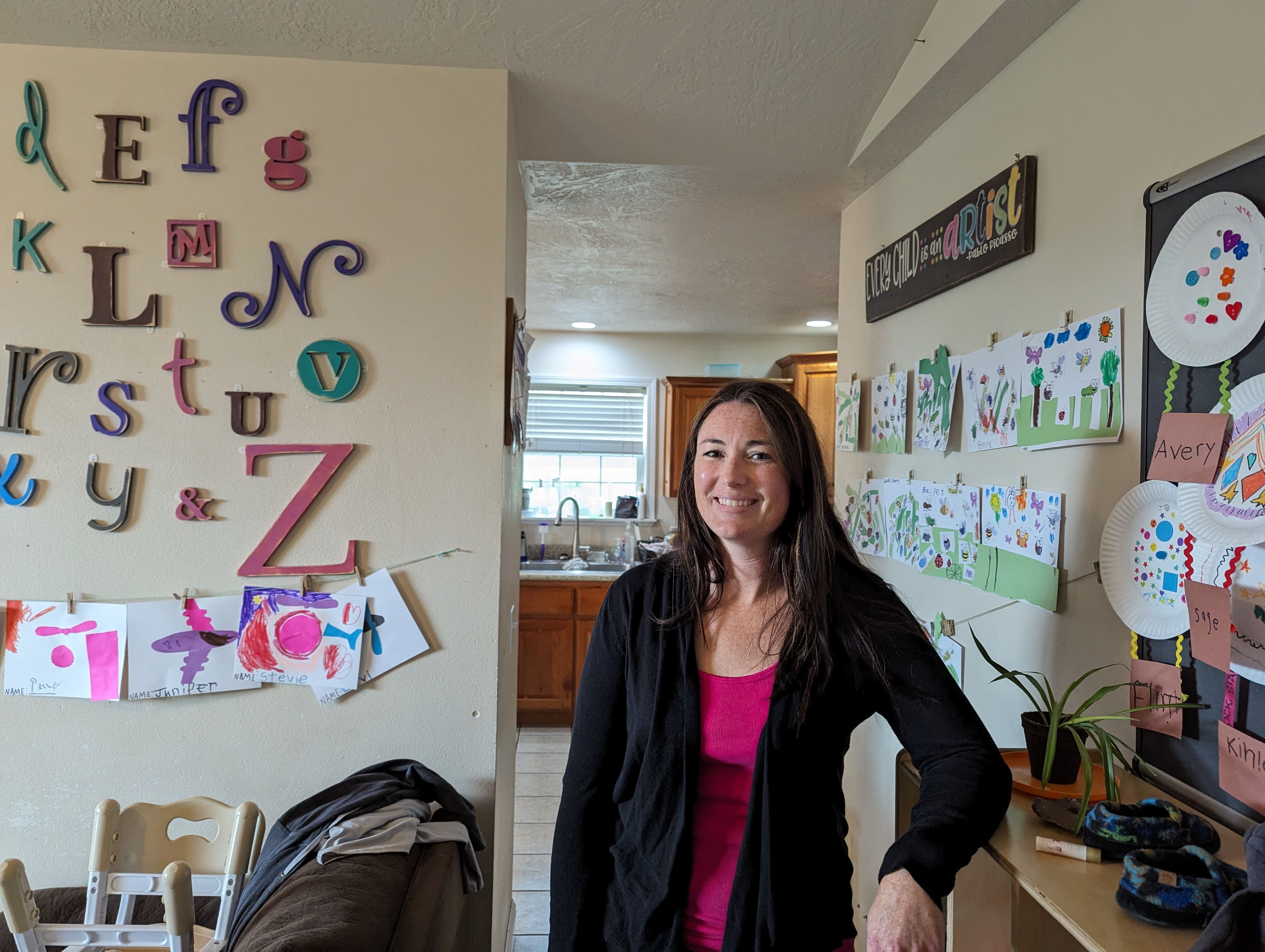Lauren Cochrane, 34, perched at the head of a long wooden table, phone in hand, checking her workday schedule out loud. One meeting at 10:30 a.m., another at 11:30. A few feet away, her husband, Kyle, 39, compared her daily calendar to his own, mapping out overlapping obligations and strategizing time slots when he could watch their 11-month-old daughter, Sloane. Between them, Sloane lifted bits of orange and homemade bread to her mouth, juice and crumbs dribbling onto her green mealtime poncho.

“It’s going to be a busy day here,” Lauren said as Sloane babbled at her side.
Until December of last year, the Cochranes relied on a hired nanny to help care for Sloane and their 2-year-old son, Howie, during the work week, splitting the cost with another family. But that arrangement expired shortly after Christmas, and the Cochranes abruptly found themselves searching for other options. They secured a spot for Howie at the Alberton Early Learning Center, a half-hour drive from their home in the forested foothills above Frenchtown. Unable to find an open slot for Sloane, Lauren and Kyle spent the winter hosting guests, family and friends from out of town who could watch their daughter while they worked.
That situation, too, proved unsustainable. So the Cochranes made the tough choice to juggle childcare with their fully remote tech jobs, working together to provide for their family financially while ensuring their daughter is fed, cared for and entertained throughout the day.
“She’s just watching you work,” Lauren said. “But in my head sometimes it’s like, I should be on the floor playing with her, and I’m up here and she’s going to be like, ‘Mom’s a slave to the computer,’ you know?”
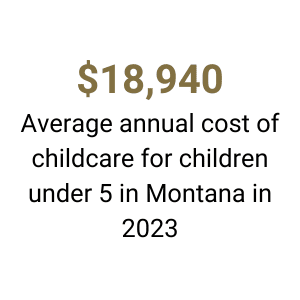
Across Montana and around the country, scores of families are struggling with a childcare crisis that is only getting worse. For some parents, the cost of such care is swallowing a significant share of their annual earnings — an average of $18,940 in 2023, equivalent to 28% of the state’s median household income, according to the Montana Department of Public Health and Human Services. For others, lengthy waiting lists or lack of local providers have made childcare unattainable at any cost. The health department estimates that Montana’s current childcare supply meets less than 45% of the statewide demand. Even if hurdles of affordability and access are overcome, parents can still struggle to find a program that fits their expectations of quality care.
That mix of challenges kept an estimated 66,000 adult Montanans from fully engaging in the workforce in 2023, roughly 11% of the total civilian labor force reported by the Montana Department of Labor and Industry for the year. That’s one of several data points that have childcare advocates and higher education calling for statewide action to fix one of Montana’s biggest economic issues.
For Leigh Ann Courville, co-director of Salish Kootenai College’s Early Childhood Education Department, childcare seems to have gained particular public attention and policy interest in the wake of COVID-19. Pandemic-era school closures highlighted the state’s dependence on family support systems that many had previously taken for granted, reminding Montana that a healthy labor force needs a healthy early childhood infrastructure in order to thrive.
That reminder has helped usher childcare access and affordability to the center of recent state policy debates, but for campus leaders like Courville, the childcare crisis is hardly news. Responding to workforce needs is a major responsibility of higher education, and SKC has been trying to topple barriers for the next wave of workers in the Mission Valley for decades. It’s one reason the college leverages grant funds to ease the financial pressure on students, Courville said, and why her program developed a one-year track to entry-level certification in the childcare field.
“We need childcare so that people can work,” Courville said, noting that the need applies not just to private sector workers but to parents who return to college to improve their earning power. “It’s not just about women and children. It’s a community, it’s a state, it’s a national thing.”
About 50 miles north of the Cochranes’ home, Hayley Salois, 34, cradled a toddler on her hip as a pair of red-haired twins crawled across the tile floor on all fours and briefly vanished beneath a low table littered with lunchtime leftovers. They reemerged, hot on the heels of a rubber ball. Salois raised the toddler in her arms for a quick diaper sniff. The results, telegraphed by her slight nod, were negative.
“We need childcare so that people can work. It’s not just about women and children. It’s a community, it’s a state, it’s a national thing.”
Leigh Ann Courville, co-director, Early Childhood Education Department, Salish Kootenai College
Salois is one of about 67 students now working their way into the childcare field at Salish Kootenai College in Pablo, directly across the highway from the headquarters of the Confederated Salish and Kootenai Tribes. She’s already halfway toward earning an associate degree in early childhood education, and plans to continue on to a bachelor’s degree.
Salois has also logged more than six months as a lead teacher in the infant-and-toddler room at SKC’s Early Learning Center, which is both a childcare provider and a training ground for the next generation of early education professionals.
Salois, who already has a paralegal associate degree, said she and her husband are intimately familiar with the childcare challenges facing families in her home state.
“I was a stay-at-home parent for so long just because childcare was so expensive. With five of my own children, there was no way that we could both work and send our children to daycare,” Salois said. She eventually returned to work as a family advocate for her community’s Head Start program, a federally funded education service offered free for children from birth to age 5, after her husband took a year off to care for their youngest child.
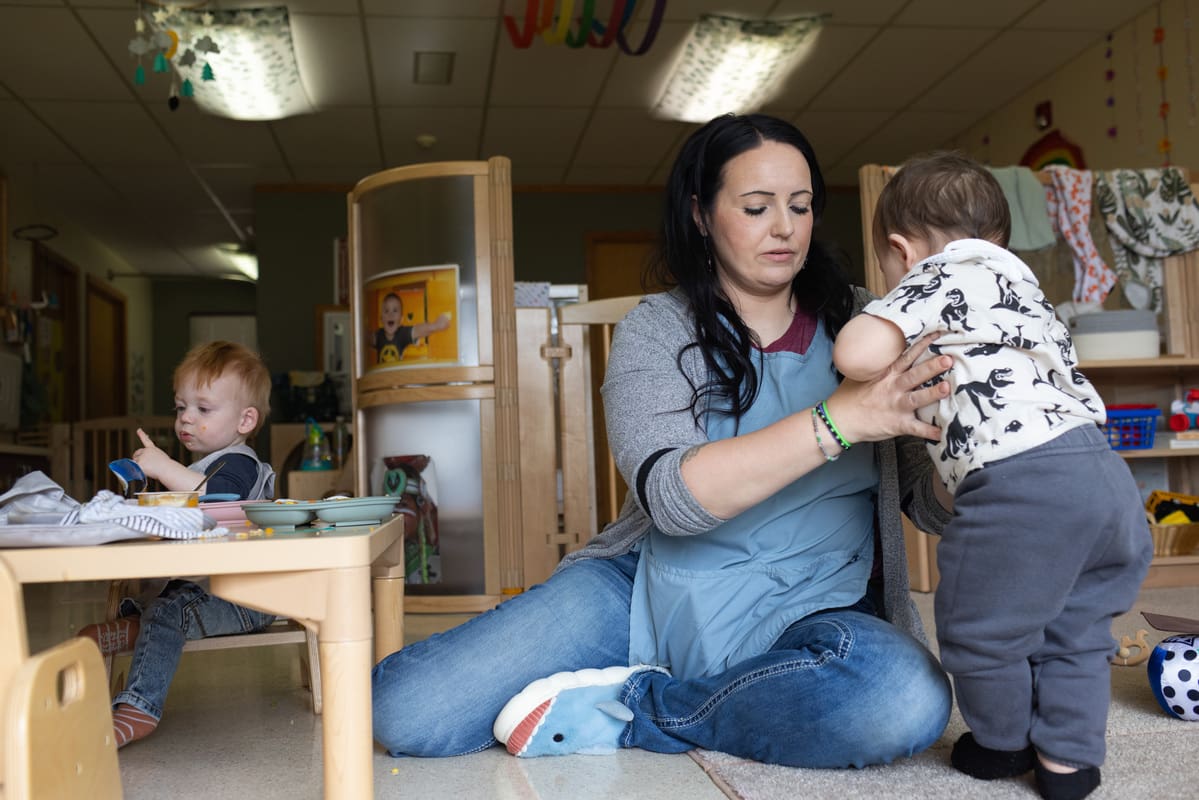
Despite her role recruiting and training a new generation of childcare workers like Salois, program leader Courville doesn’t shy away from the hard truth.
“Generally, early childhood [education] has been underfunded,” Courville said. “Our wages are not on parity with other professionals in comparison to public school systems. Yet more and more [childcare employers] want associate’s, bachelor’s, master’s-level degrees. But the salaries don’t always match that.”
Montana’s childcare system is beset by disparities. The majority of the state’s counties meet the national definition of childcare “deserts,” meaning licensed capacity meets less than a third of potential demand. The median wage for childcare workers in the state was $12.84 an hour in 2022 — about $2 less than the national median — and providers seldom offer employee benefits such as health insurance. The early childhood education profession can be a tough sell to prospective students, especially when it’s coupled with the rising price tag of a college degree.
Montana’s last-in-the-nation ranking for starting public school teacher salaries makes pivoting into a related career equally fraught.
“It’s a hard time to be a teacher,” said Allison Wilson, director of the Institute for Early Childhood Education at the University of Montana. “It’s a hard time to be a childcare provider.”
RELATED
One Montana woman’s childcare travails
Ever since her earliest days in early childhood education, Amanda Wiseman has felt that her chosen field is “underappreciated.” Her first job as a teacher, at a private preschool program in Missoula, paid about $14 an hour, and while she has heard elected officials pay lip service to the profession’s importance, she continues to labor under the impression that many people “don’t take early-ed teachers seriously.”
Providing childcare in Montana, for love and money
As dedicated to her work as childcare provider Becca Brush is, after 18 years she’s looking for a change. She recently earned her associate degree in early childhood education remotely from the University of Montana-Western in Dillon, and is on track to earn her bachelor’s degree in fall 2026. Her end goal? To transition into teaching in the local K-12 school system. Why? Financial sustainability.
Wilson noted that Montana’s university system has divvied up programming for early childhood education, a discipline she and others in the field define as encompassing not just infants and toddlers but children in their first three years of elementary school. Wilson’s own program focuses primarily on pre-kindergarten through third grade, with college students earning state P-3 teacher certification along with a degree. Associate degrees and certifications related to younger ages tend to be found at smaller two- and four-year state campuses or tribal colleges, while the state’s other flagship, Montana State University in Bozeman, offers various degrees and provider trainings for both preschool and early elementary levels.
Wilson and others cautioned, however, that the workforce pipeline feeding the childcare system has historically not started within higher education. Entry-level provider positions don’t require a college degree, and even if such requirements did exist, Wilson stressed, the low wages endemic to the profession wouldn’t match the rising cost of attending college.
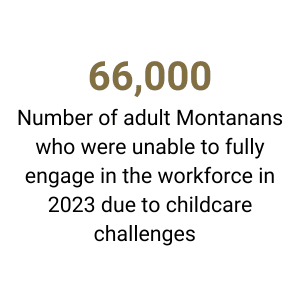
Absent some sort of public subsidy, Wilson said, she doesn’t see how the pipeline could be reconfigured to meet the workforce needs of childcare providers — at least not without saddling families with higher rates.
“The reason that works in K-12 education is because it’s publicly funded,” Wilson said. “The cost does not fall on parent[-paid] tuition.”
There are exceptions, of course. Missoula resident Amanda Wiseman, who this fall will begin pursuing her master’s degree in early childhood education under Wilson’s tutelage, started on the path as an undergraduate at UM-Western in Dillon. From there she landed a teaching job at a Missoula area preschool, and two years later advanced to directing the program.
But six months after giving birth to her and her husband’s first child, Wiseman came to the same decision so many other new parents have made: She quit her job.
“My whole paycheck was literally going into my pocket, then straight to [childcare],” said Wiseman, who made $16 an hour as program director. “So we decided I would just stay at home with him.”
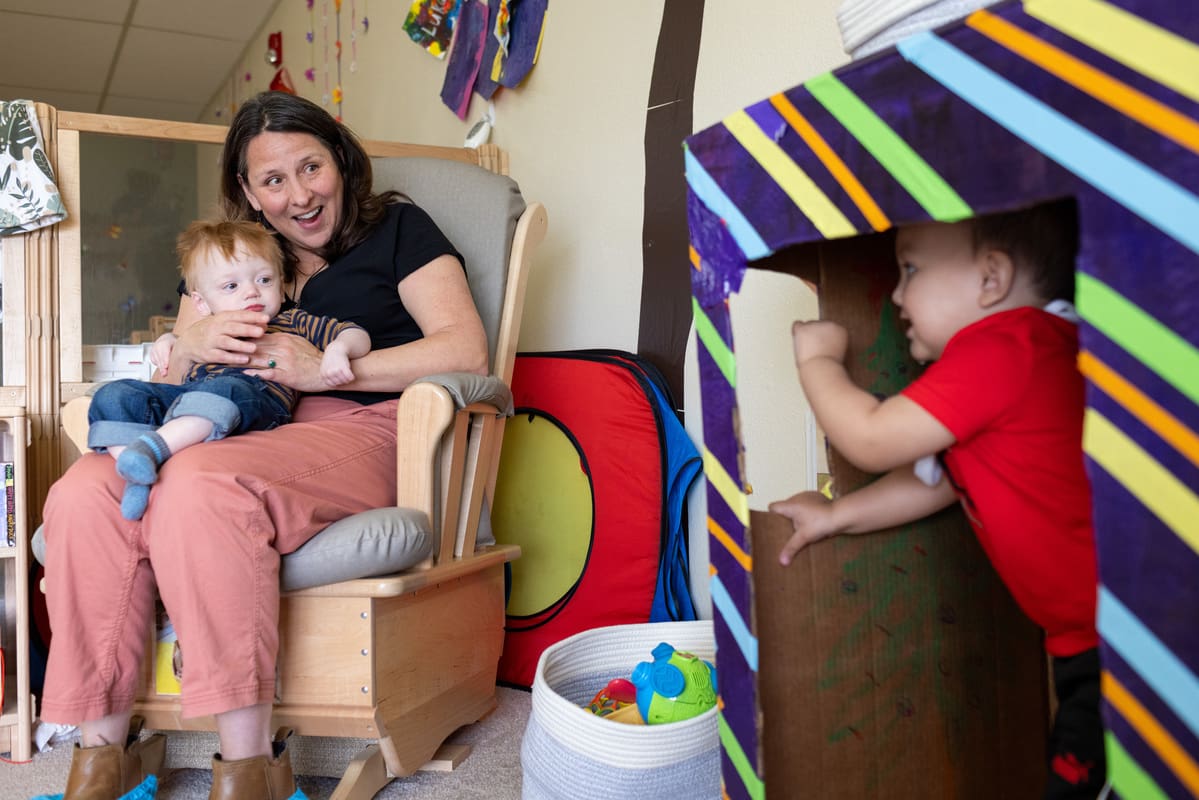
Wiseman wasn’t alone. She spent those years with a coterie of stay-at-home mom friends who’d made similarly tough professional choices. But with her son approaching kindergarten and her 3-year-old daughter enrolled at UM’s early education lab school — a dual childcare provider/training facility similar to SKC’s early learning center — Wiseman said she’s ready for a more specialized course of study and a return to a career she’s long been passionate about.
Such career decisions require a balancing act — passion versus compensation — that Kelly Rosenleaf, executive director of the Missoula nonprofit Child Care Resources, said is damnably difficult for childcare workers to pull off.
“It’s emotionally and spiritually rewarding work,” Rosenleaf said. “But at the end of the day, you have to be able to feed your family, and you have to feel like you’re going to make it in retirement, and you’ve got to have health insurance. Those are just systemic problems because it does not pay enough. And yet parents are struggling to pay.”
Kyle Cochrane always wanted to live on the outskirts of his hometown. A Missoula native, he grew up on the banks of the Clark Fork, which flows just a few city blocks from his alma mater, Hellgate High School, on its way west to the rural foothills where he now lives with his family. He met Lauren a month after she moved to Missoula from Minnesota’s Twin Cities in 2018, and within a few years the couple found their dream home surrounded by trails and towering pines in nearby Frenchtown.
“It’s emotionally and spiritually rewarding work. But at the end of the day, you have to be able to feed your family, and you have to feel like you’re going to make it in retirement, and you’ve got to have health insurance.”
Kelly Rosenleaf, executive director, Child Care Resources
The Cochranes count themselves relatively lucky among their fellow Montanans struggling with childcare. They’re able to afford a nanny one day a week. And come August, there’s a good chance the early learning center in Alberton will have space for Sloane to join Howie. Those strokes of good fortune have given the Cochranes a degree of freedom and flexibility they understand many Montana families don’t have.
But their situation nonetheless exacts a personal and professional toll, and the abrupt loss of their nanny-share arrangement last year is evidenced by small but meaningful alterations in their work-from-home lives. Lauren has taken to stationing herself in the living room for portions of the day, standing with her laptop at a tall side table while Sloane plays on the carpet. Both parents have had virtual meetings interrupted by the calls of a child. They regularly eat lunch together with their daughter and make a point to take breaks for time outdoors with Sloane and the family’s two dogs. The Cochrane parents agree that there are pros to their reality, and there are cons.
“Raising two kids is hard,” Kyle said. “You add on any additional stressors, it’s amplified.”
One of the family’s most notable changes is their half-hour morning drive from Frenchtown down the Clark Fork to Alberton, where two-year-old Howie spends most weekdays on the second floor of a white house with green trim and a wide, wood-railed veranda. If all goes according to plan, Sloane will join her brother here starting in August — just as soon as Alberton Early Learning Center director and owner Felicity Day has the capacity to take her on.
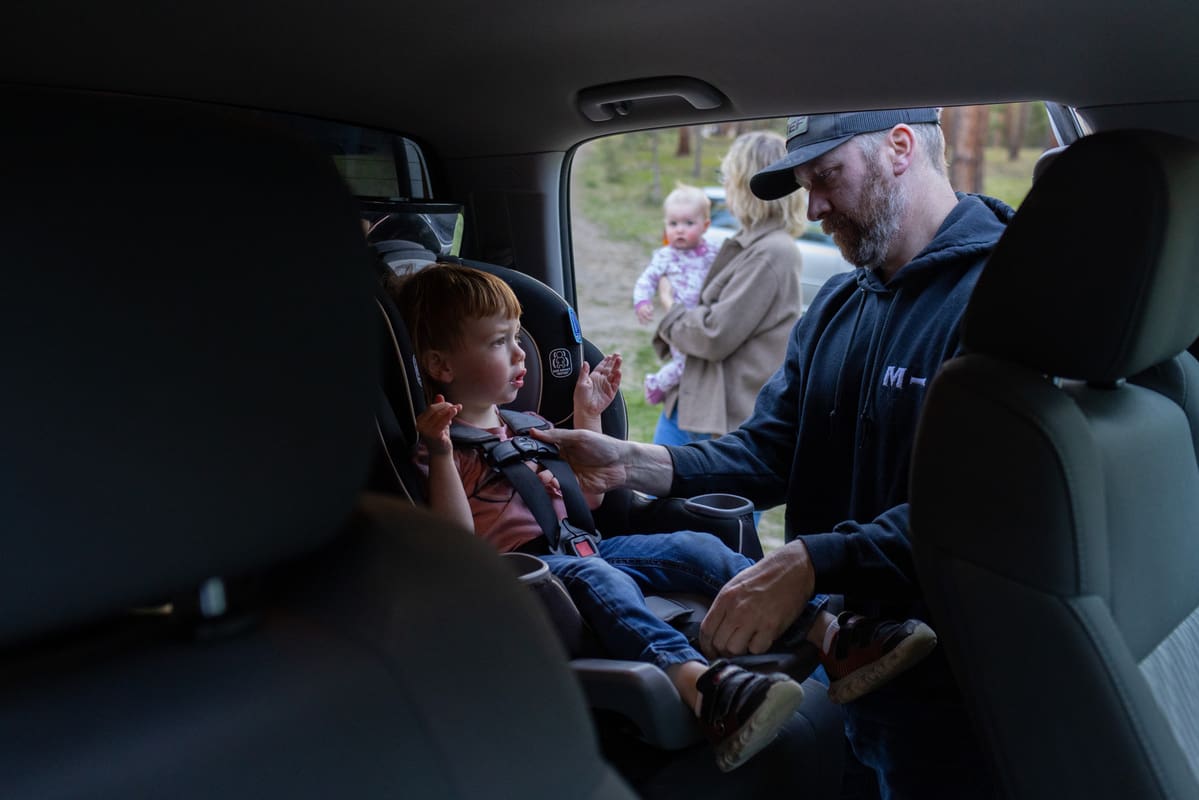
The Cochranes aren’t the only family holding out for an opening at the Alberton Early Learning Center. Day said she currently has eight families on her waiting list, and is still keeping three others in mind who recently withdrew from the list. Local interest “exploded fast” when she started the center two years ago, she said, a development she partly attributes to the fact that surrounding Mineral County has only two other registered providers with a combined capacity for 16 children.
Day enrolls up to 15 students, in line with state-mandated provider-to-child ratios. She’d love to increase that total, but that would require finding another employee with the knowledge and experience in early childhood development that she expects her program to deliver.
“That’s the hardest part for me,” Day said. “I can hire anyone off the street, right, to come and help. It’s people, it’s bodies, we need bodies to satisfy that ratio. But is it this? Can they do this? No. And that’s the problem that I am having.”
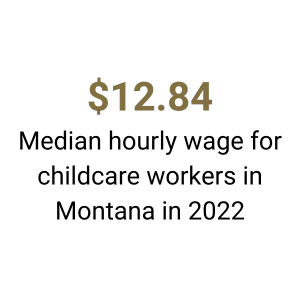
Day leaned heavily on a $500,000 two-year grant from the state to keep her rates below $40 a day early on. But with the grant expired and operational costs increasing, Day had to raise rates this spring, and while she’s done so gradually — a dollar a month to help parents adjust, with an August target of about $47 per day — Day said she remains concerned about the impact on local families.
Childcare costs already amount to between 11% and 13% of the median household income in Mineral County, according to the U.S. Department of Labor. The federal benchmark for affordability is 7%. Day is aware that parents in her rural community don’t make much money, and she knows they’re “not happy” that childcare is about to get more expensive.
“We have some families who are taking on a second job in order to keep their children here, we have some families who are only going part-time because they can’t afford full-time [care],” Day said. “I’m working with families on payment plans, everything we can do in order to keep children here, because our rates are going up substantially.”
Despite bitter disagreements on a range of politically hot topics in recent years, Montana lawmakers from both sides of the aisle often find common ground on policy proposals impacting children and families. The 2023 Legislature passed a slate of bipartisan laws that enhanced state funding for kindergarten readiness programs and boosted a poverty-based childcare subsidy called Best Beginnings by $14 million.
Republican Gov. Greg Gianforte has lauded those investments, saying childcare providers “support hardworking families, strengthen our economy and build a brighter future for our state.” The work remains an ongoing priority for the Department of Public Health and Human Services, which is now crafting a three-year plan to utilize $32 million in federal funds designed to make childcare more accessible for low-income families. Part of that plan, slated to go into effect in October, involves distributing Best Beginnings reimbursements to providers on behalf of eligible families at the start of the month rather than the end, directly addressing a challenge reported by 40% of home-based and center-based providers surveyed by the department last year.

Other regulatory proposals meant to bolster the childcare workforce and enhance early childhood instruction have stalled out. Legislators this spring rejected a complete overhaul of Montana’s childcare rulebook by the state health department. The agency pushed back, defending its work as a multi-year, stakeholder-led effort to fix “confusing, poorly arranged” regulations that discourage new childcare providers from entering the system.
The rewrite tried to alleviate concerns about provider licensing, safety requirements, environmental definitions and age-based distinctions. Changes regarding vaccine requirements and religious exemptions proved to be a particular point of friction with Republican members of a legislative interim committee, which extended its months-long objection to the new rules package on May 9.
Such developments have many childcare advocates looking ahead to the 2025 legislative session as an opportunity to advance reforms.
RELATED
How childcare shortages undermine rural communities
With pandemic-era federal funding support at an end, policymakers and researchers fear that inequitable childcare access threatens the sustainability and longevity of rural communities. In eastern Montana, childcare provider Candy Murnion understands.
Childcare is scarce and spendy. Here’s what Montana lawmakers are doing about it
New childcare laws, including a spending measure signed by Gov. Greg Gianforte this week, expand the state’s Best Beginnings subsidy program and deregulate small home-based daycares.
Grace Decker, who heads the Montana Budget and Policy Center’s statewide childcare initiative, said building bipartisan coalitions and crafting policies that foster financial stability and growth for childcare providers will be critical next year if lawmakers want to improve the lives of Montana families.
“There are a couple of really important levers in this system that we need to be paying attention to,” Decker said, “to just continue to protect the things that have already moved forward and also advance an infrastructure for childcare that looks at the needs of families and providers and the whole community.”
Stability and growth are front of mind for provider Felicity Day as she maneuvers to meet the heightened demand among families in her small community. Walking in the door of Day’s learning center along Alberton’s quiet main drag is like stepping onto the set of a PBS Kids program. Color dances in every corner, from the bright yellow rain suits hanging in cubbies to the lettered plastic popsicle sticks clutched in the hands of half a dozen small children. In the center of the room a turtle named Tim hovers in a murky aquarium, and on a recent spring morning students sang a special song about Tim before diving into a morning of lessons about the letter N, rhyming words and peaceful conflict resolution.
“Everything we do has a ‘why’ behind it,” said Sheri Arnett, one of Day’s two full-time employees, as she prepared the center’s handful of toddlers for a pre-lunch excursion into the freshly rain-sodden backyard.
Day, a third-generation childcare provider, built the Alberton Early Learning Center on a Montessori model. Schedules revolve around play-based learning, with presentations and group crafts built around a weekly theme. Day doesn’t simply discuss the weather. She demonstrates the physics of it by dropping plastic bags and tissues into a plastic wind tunnel and helping students affix paper raindrops to cotton-ball clouds.
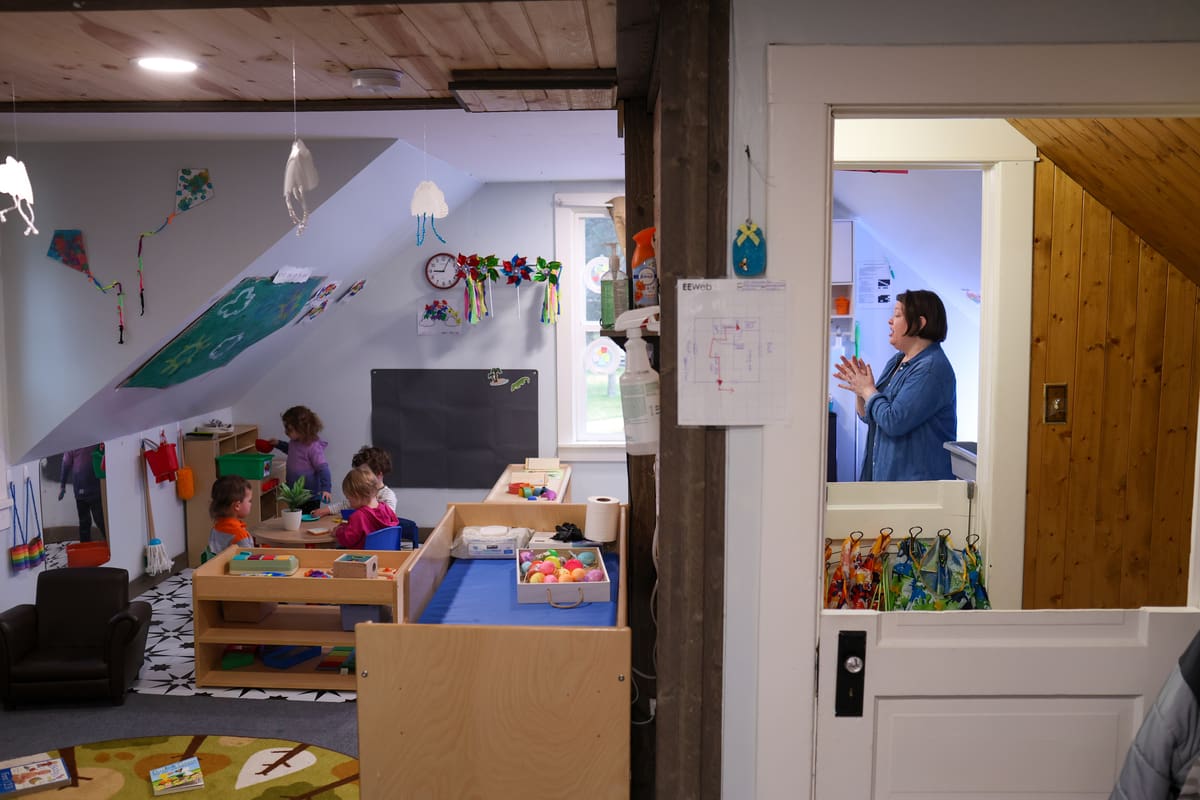
Day is actively working to hire more staff this summer, and said attracting quality educators requires offering them an hourly wage well above $14 — the national median for childcare workers. Paying her employees an attractive wage and expanding her business to accommodate more children are important goals for Day. But for her and many other providers, childcare is about much more than keeping a watchful eye on youngsters. It’s about recognizing a child’s earliest years as a key point in human development and nurturing inquisitiveness, social responsibility and healthy emotional regulation. Alberton area mother Kim Williams, who enrolled her daughter Hadley here in late 2023, has already noticed a shift in her child’s formerly shy demeanor.
“It’s been so awesome to see her blossom,” Williams said, standing on the front porch after dropping Hadley off. “She’s becoming a little person here.”
How future policy can support such services is a foundational question for Montana families, providers and college students looking to join the childcare workforce. The rates families pay, the wages childcare workers make and the costs those workers incur in training to enter the profession are all strands in an intricate web. Pluck one and the effects reverberate across the system.
“There needs to be some sort of public investment in child care. Because if we can’t pay professionals a living wage to work in childcare programs, we’re not going to have enough childcare programs to operate for families to have slots. And then it becomes a family issue.”
Allison Wilson, director, Institute for Early Childhood Education, University of Montana
The state’s universities are still trying to find solutions, too. For Allison Wilson at the University of Montana’s Institute for Early Childhood Education, the inclusion of state funding in any state-level conversation is critical to strengthening the system for everyone and signaling to prospective childcare workers that Montana truly values the profession.
“There needs to be some sort of public investment in child care,” said Wilson, who earlier this spring hosted her institute’s second statewide summit at UM, drawing early childhood education professionals from across the state and region. “Because if we can’t pay professionals a living wage to work in childcare programs, we’re not going to have enough childcare programs to operate for families to have slots. And then it becomes a family issue.”
Kelly Petersen stood next to a large terrarium in the dimly lit preschool room at Salish Kootenai College’s Early Learning Center, gazing at the saucer-sized leaves of the pumpkins planted there by her students. Beyond the large windows, ponderosa pines lined the maze of parking lots and buildings at the center of the Confederated Salish and Kootenai Tribes’ campus.
Petersen applied for a position at the center shortly after arriving in the Missoula Valley from Gillette, Wyoming. The job, she said, provides an outlet for “just about everything” she’s learning in the college’s classrooms on her way to a certificate in early childhood education. It’s a credential she expects to be a good professional complement to her bachelor’s degree in art education.
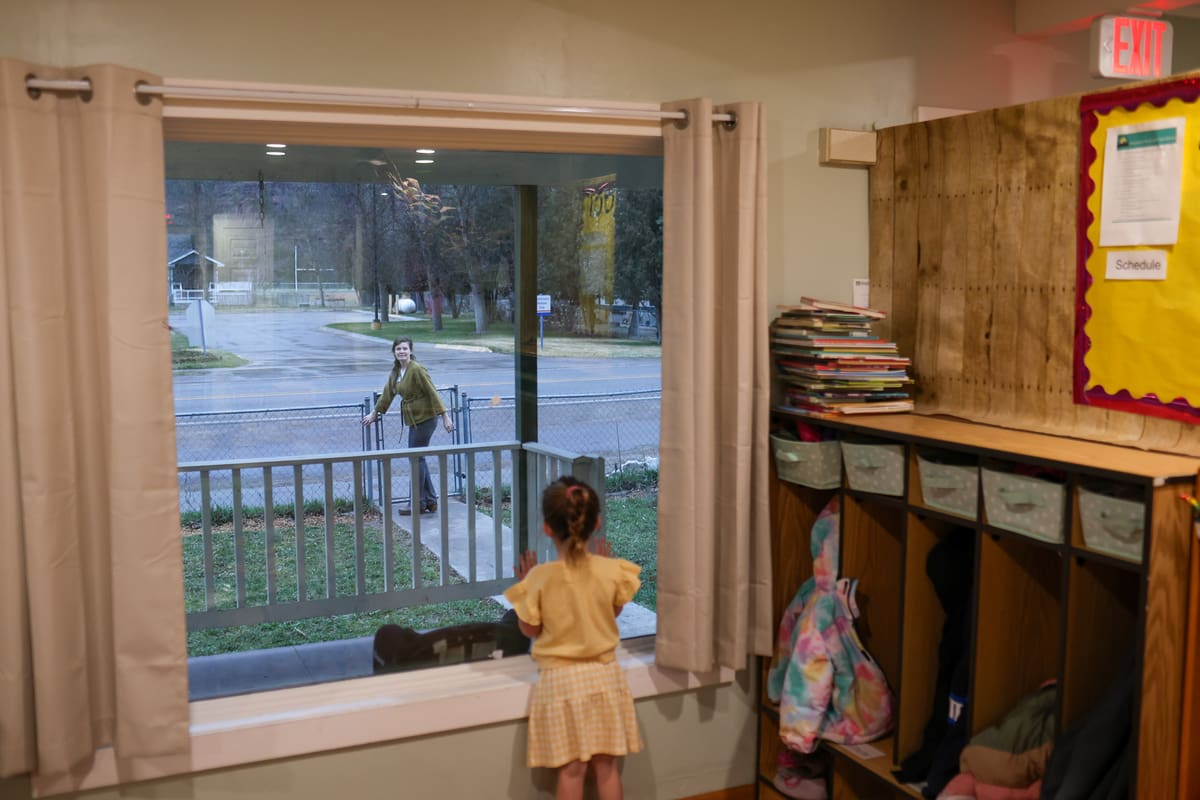
“I want to be here for quite a long time, just because they give us so much support here and I think it’s a really great place to grow,” Petersen said of the center. “Then if I want to I can go teach middle school art or I can go teach high school art. Right now, though, I’m just really liking the preschoolers. They’re so much fun.”
No two origin stories are quite the same in the childcare profession, but the underlying draw — caring for children — is consistent among new recruits and veterans alike. Julie Allen, a fellow student of Petersen’s at SKC, ran her own childcare business on the Flathead Indian Reservation for roughly 40 years before returning to school for an associate degree. Amanda Wiseman, who will start on her master’s degree at UM this fall, traces her own passion for early childhood education to her high school days as a peer mentor in Helena’s Head Start program.
“I love that three- to six-year-old age range. It’s my favorite,” Wiseman said.
BriAnne Moline first discovered her love of early education 16 years ago, after the birth of her first son. She initially looked to UM to pursue her aspirations, but at the time the flagship campus offered only an elementary education degree, so she pivoted to UM-Western in Dillon, where she earned an associate degree in 2014.
Today, Moline owns and operates Wild Wonders Early Learning Center out of her home on the Clark Fork between Missoula and Frenchtown, and has emerged as a statewide advocate for families and fellow providers.
She facilitates online leadership training programs for the National Association for Family Child Care, is part of a national provider collaborative called Home Grown Child Care, and co-founded and co-directs the Montana Family Childcare Network. In 2022, Moline helped spearhead a rally on the steps of the Missoula County Courthouse to raise public awareness about low wages and employee retention in the childcare business. She organized a similar event in Missoula earlier this month.
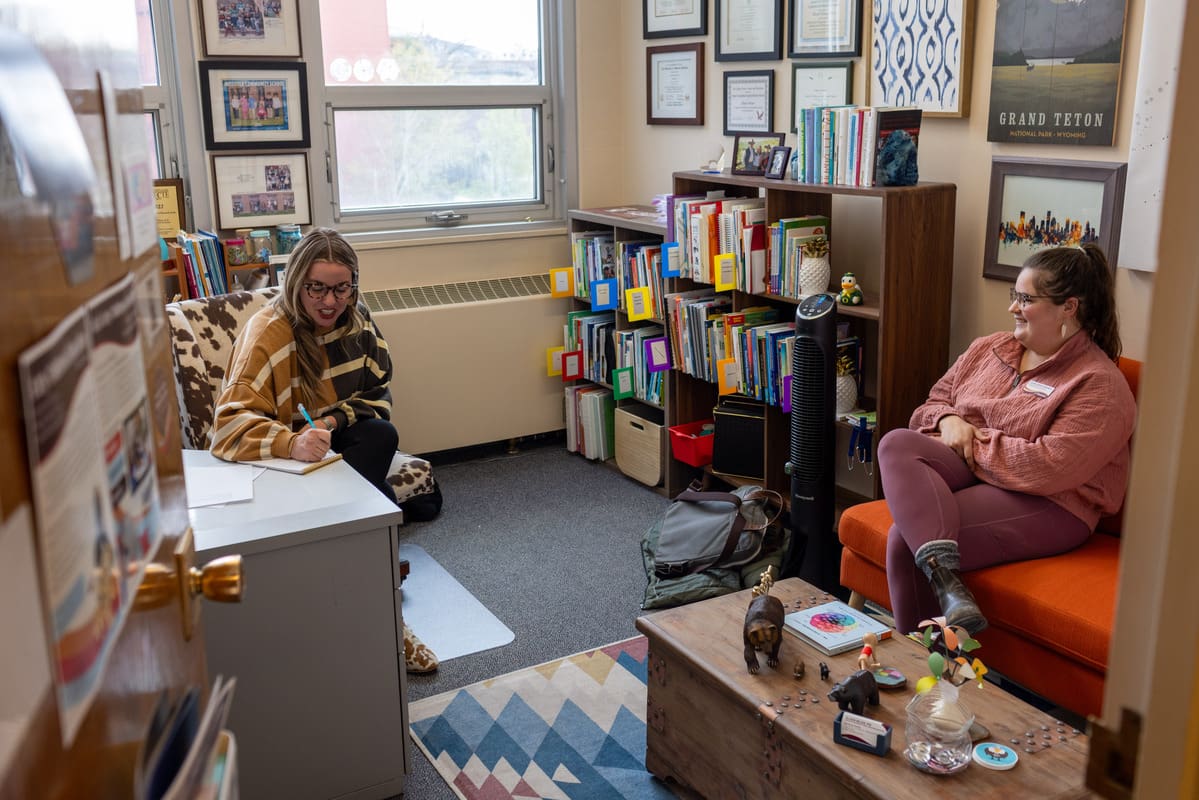
But the profession has not been easy on Moline. In 2018, she was forced to relocate her business twice due to the reluctance of property owners to rent to childcare operations. The second relocation came when she was several months pregnant. And in order to support her own four children, Moline cut operational costs last year by eliminating the last of her staff and downsizing her focus to infants and toddlers. She now flies solo as a provider, and estimates she made $35,000 in 2023 — the same year she was able to complete a bachelor’s degree she’d started more than a decade prior.
“Now I have $60,000 in [student] loans and I still qualify for Medicaid and food stamps,” Moline said, estimating that she works well above 40 hours a week in childcare.
Despite the financial headwinds, Moline continues to serve a cluster of families who are facing similar struggles and view her as an essential part of their daily lives.
And like other providers, Moline is actively pushing new ideas she hopes will bolster the system with new recruits, easing the pressure on both families and other childcare workers. During the 2023 legislative session, she advocated for the establishment of a tax credit for licensed early childhood educators working in registered programs. It didn’t pass, but Moline said she’s also been lending her insight to state-level conversations about expanding apprenticeship opportunities for the early education field.
Montana officials have already invested considerable focus and funding in similar initiatives for the construction, teaching and health care professions. For such an effort to be successful in the childcare sphere, Moline said, “there needs to be financial supports for these people coming in, there needs to be financial supports for these programs who are offering these opportunities.”
Change in childcare needs to account for shifts in the working lives of families, too, said Angie Armour, executive director of the nonprofit Raise Montana. Like Moline, Armour has devoted much of her professional energy to raising awareness about the challenges facing providers and the families they serve. It’s not enough to support an outdated model of childcare, Armour said. The modern workforce is different than it was half a century ago, and improvements to Montana’s childcare system should account for the needs of parents navigating an altered employment landscape.
“A lot of people are not working that 9-to-5 job anymore,” Armour said. “So the traditional hours that childcare was providing is not fitting that need for a lot of families.”

Back in Frenchtown, high on their forested hillside, Lauren and Kyle Cochrane remain all too aware that they’re not the only ones piecemealing temporary solutions to a complex and frustrating problem. They appreciate the quality experience Felicity Day has provided for their son at the Alberton Early Learning Center, and in light of their family’s financial stability, Lauren said, they’d be willing to pay more to support Day’s operation. But they also recognize that the systemic nature of Montana’s childcare challenges means some solutions will have to come from within their own family, even if that means keeping one eye on a child and the other one on work.
“It does make you feel a little bit like you’re on an island,” Lauren said. “I think that’s broadly applicable to anything childcare-related or parenting-related. You’re on an island and you’ve got to do the work and figure it out for your family. Nobody else is going to do it for you.”
This story is a collaboration between Montana Free Press and Open Campus, with support from Ascendium Education Group.
LATEST STORIES
Reported birth of rare white buffalo calf in Yellowstone National Park fulfills Lakota prophecy
The reported birth of a rare white buffalo in Yellowstone National Park fulfills a Lakota prophecy that portends better times, according to members of the American Indian tribe who cautioned that it’s also a signal that more must be done to protect the earth and its animals.
Can Dems keep winning in Indian Country?
Tribal communities have for decades been an essential part of the voter base that gives Montana Democrats the ability to make competitive bids for statewide office. A close look at turnout figures for June 4 party primaries in the state’s eight majority-Native districts, however, indicates there may be cracks in that coalition.
By the Numbers: special session edition
Three distinct calls for special sessions of the Montana Legislature have been voted down in mail polls, per results announced by the Montana secretary of state.



